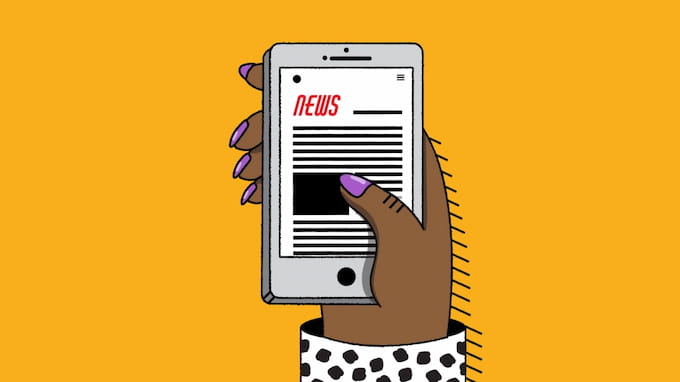In addition to some significant efforts that you may have read about in recent weeks, the Labs team has been working on a variety of smaller, but equally important, projects that affect our existing products. One such development is the most recent production deployment of the Social Reader web app.
To learn what changes have been made and what’s new in the latest version of the app, we spoke with two team members who have been intricately involved with the development of Social Reader, albeit from different ends of the spectrum: designer Camellia George and engineer Charles Covey-Brandt.

What is your role at WaPo Labs?
Camellia: I’m an interaction designer (currently the only one, but we’re looking for another). I consult on user experience, information architecture, and interface design for all the product teams. Some days that means advocating for a particular user experience on Social Reader; other days, I’m elbow-deep in pixels creating buttons or typographic styles on Trove.
Charles: I’m the technical lead for Washington Post Social Reader – I inform the direction of the product while translating specific features into technical tasks and broader architectural decisions.
In which ways have you been involved with the development of Social Reader?
Charles: The great thing about being on a small team like WaPo Labs is that we all get to be involved with almost every aspect of our products. My “official” role is technical lead, but given the complexity of the technologies involved, I help define the product as well as manage the execution.
Camellia: I joined the Labs team just a few weeks before Social Reader launched, so I wasn’t involved with its initial development. But as soon as it launched, I played the role of loyal critic — I had enough distance to critique which aspects of the product were clear, and which weren’t.
Shortly after launch, I began working on a mobile version the Social Reader app. I sketched out that user experience (think wireframes and behavior flows) which were then used to design both the functional structure and as a basis for the interface design.
What’s new about this latest deployment?
Charles: This latest deployment is all about consolidating the Social Reader brand around a single identity and building a flexible design to accommodate new features slated for later this year. We’re also doing the same thing “under the hood” by refocusing the underlying architecture to support the new features.
Camellia: The most obvious changes are new typography, a more sophisticated color palette, and a stronger presence of our brand. Another change you might notice as you click around is the level of interactivity we’ve paved the way for: in the future, Social Reader will function less like a website (where links direct users to new pages) and more like an app (which responds to user actions to reveal and refilter information).
What are some specific examples of Social Reader features that have been improved in this latest deployment?
Camellia: One thing our readers might notice right away is a new stream of content at the top, above the article headline. This new feature allows us to experiment with different content streams — editorial, topical, trending locally, what your friends have read, what they haven’t read yet, for example — to help our users find new content that’s most interesting to them personally. Before, this space was just a basic “trending across the app” stream.
What was your thought process behind making these changes? How will the improvements contribute to the quality of the product?
Camellia: Above all else, I wanted Social Reader to have it’s own perceptible identity. That’s a matter of both visual branding (colors, type, logo, tone) and interactive personality (a comprehensible and predictable hierarchy of information, interface patterns that are used throughout the app, etc).
When a product is overly generic – when it has no discernible personality – users project their expectations and desires onto the product. This is an impossible bar to reach, because no one product or company can be everything to everyone.
Charles: On the geeky side: the new release focuses on fully implementing the ActivityStreams spec throughout the service layer and client side javascript. This allows us to move quickly as we experiment with and implement new features. The new release is also smarter about client-side caching, so the application will seem snappier after the first load, and we’ve consolidated into a single code base across all of our platforms, which means our code is smaller and easier to maintain.
Social Reader’s user base is growing rapidly. Why do you think it is so popular?
Camellia: The biggest reason for this, in my opinion, is that Social Reader expands on a behavior already present in Facebook: reading articles and sharing them with your friends. I love approaching new products by building emergent behaviors into the system. For a lot of people, who share everything they read, this product is exactly what they have been waiting for!
Charles: We’re discovering that people like to read articles that their friends are reading. We have a great platform for sharing this information, and a great partner (Facebook) working with us to expose the platform to a huge audience.
What do you see in the future for Social Reader?
Charles: We originally focused the product around the less engaged user – keeping things simple and unobtrusive to get the reading started. Now that we have an audience, we are working on tools and resources for the more engaged users, from basic search to levers that influence system algorithms.
Camellia: I expect that Social Reader will keep growing and I imagine the base of users will expand demographically as implicit sharing becomes more widespread. As that happens, the features we develop will evolve.
Wapolabs USA
- Address: 1301 K Street NW Washington, D.C., U.S. 20071
- Phone: 0190-8286
- Email: [email protected]
- Website: https://www.wapolabs.com
- Instagram: https://www.instagram.com/wapolabs/
